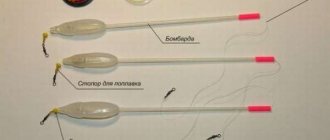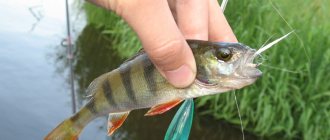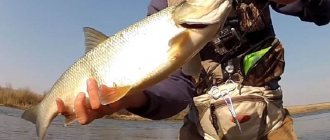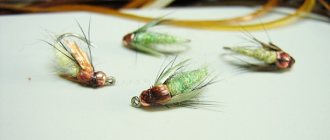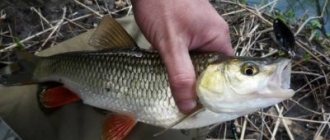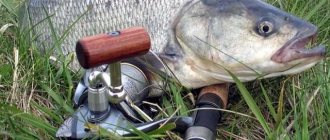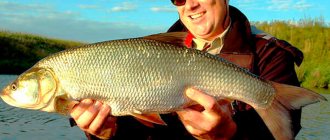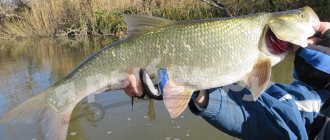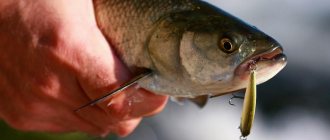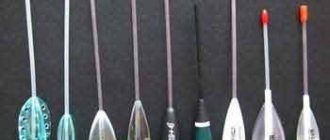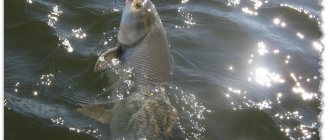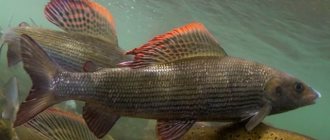Yuri 09.10.2020 874
Catching a large trophy asp is the dream of any fisherman. The popularity of this beautiful, strong and cautious fish in Astrakhan is quite high. Not every spinning angler knows the intricacies of catching this predator, and only the most experienced know their habits, habitats and food preferences. Such knowledge and properly selected gear ensure fun asp fishing. Today we will talk about flies - how to use a front sight with a bombard and castmaster.
Lures for asp fishing
7 minutes Author: Dmitry Tishchenko 948
Asp is a representative of the ichthyofauna, a desired trophy for many domestic spinning anglers. It attracts fishermen with its swiftness, speed, sharpness and beauty. Every novice fishing enthusiast wants to catch him.
The key to fishing success is correctly selected bait for asp. This is a huge diverse category of specialized spinners, wobblers, various equipment and installations. In this material, we will look at what a foal hunter’s arsenal should consist of, what to put in the box first.
Requirements for baits
Today, the fishing market offers a huge variety of baits that can be used in asp hunting. There are narrowly targeted models, developed for specific conditions, and there are universal “fighters” that catch predators everywhere.
In order for a bait to be considered asp bait, it must meet the basic requirements for this type of fishing:
- Maximum resemblance to the asp’s main food item – a small, narrow-bodied fish;
- Realistic movements that do not cause alertness in the predator;
- Natural or neutral colors;
- Can be used in strong currents.
If asp fishing is carried out in large water areas, the fish does not allow the angler to get close to it, then an important characteristic is the ballistic data of the bait. When fishing in limited areas or small rivers, this indicator plays a secondary role; the realism of the catch comes to the fore.
Varieties
You can catch an asp with many baits. Each is endowed with special performance characteristics that ensure their successful use in certain conditions. For consistently effective sheresper fishing, you need to have different models and types of bait in your arsenal.
Below we will consider each category of artificial spinning baits separately.
For many anglers, the main lures for asp are jigs. They are narrow-bodied vibrators characterized by high flight characteristics. Can be used in any conditions. Sherespers are caught from the surface, in the thicker water, at the bottom. They operate a full season of open water on rivers and reservoirs where this representative of the ichthyofauna lives.
Jigs are baits for catching asp that do not have a game as such. When casting, they oscillate with low amplitude, and the predator is attracted mainly due to the glare from the edges of the spoon and the noise effect from high-speed wiring.
The most famous lure of the jig class is Kastmaster. In addition to it, the following models of oscillators can be noted:
- Trophy;
- Hopkins;
- Kukri;
- Renegade Iron Minnow and others.
Jigs are fished in a variety of conditions. Their main purpose is to fish for “cauldron” asp from a long distance. In terms of flight performance, they have no equal. They allow you to fish where other artificial baits are powerless.
In the cold season, when the activity of the sheresper decreases, it does not appear on the surface; jigs are successfully used in the water column and at the bottom. The bait is usually cast in waves or in steps. Periodic addition of jerking elements is allowed.
Streamers, flies
Asp flies are effective fly fishing baits that are successfully used by spinning anglers. Using them separately or in combination with spinners and wobblers, it is possible to significantly increase fishing efficiency and increase the number of bites realized.
The simplest vabik is easy to make with your own hands. To do this you will need a single hook of the appropriate size. An edge of goat hair or other similar material is formed on it; red thread will do. That's it, the fly on the asp is ready.
Often wabiki are tied in front of baits. This pairing with jigs is especially productive. Such equipment creates the illusion of a predator chasing the fry, which causes excitement in the asp. He is unable to resist and pounces on the lure escaping from him.
The described technique has long been used by spinning anglers. They call it a “beard”. Instead of bait, you can tie a regular eared sinker at the end of the thread. You will get something like a diverting leash. The equipment works well in all horizons; its effectiveness is not affected by the mood of the predator.
A large streamer, which already weighs several grams, is used as an independent bait in the ultralight direction. It is effective at close range and is suitable for hunting on small rivers.
Devons are a specialized bait designed for fishing sheresper at a long distance in the upper layers of water. The best results are shown in the summer, when the predator feeds from the surface, attacking small fish gathered in schools.
Devon is a turbine mounted on a wire axle. Rotation occurs due to the drag of the blades located on the body of the bait. As a result, the spoon creates strong turbulence, attracting the attention of the predator.
Devons can be classified according to the following characteristics:
- Body shape: flat, round, faceted;
- By the number of blades - one, two, more than two;
- About the material - all-metal, cast lead, hollow, plastic;
- In the direction of rotation of the body - left, right.
Asp Devons drive at high speed. The bait should go close to the surface, leaving a trail behind it and creating a “breaker”. The illusion of a frightened fry running away is created. An active sheresper responds well to such a tasty object.
Rotating spoons catch asp from close range. Some models allow you to fish at medium distances. This category of spinning lures is distinguished by a noticeable attractive game, stable operation and ease of learning. Fishing with spinners is easy for every beginner; serious experience, specialized skills and special gear are not required.
The best spinners for asp fishing are models with elongated petals of the “willow leaf” type. They have the following advantages:
- decent flight data;
- minimal drag;
- stability in strong currents.
Such spoons are easy to cast in a high-speed manner. They do not get lost in the game when it is served at different angles to the water flow. A good addition to any spinner would be a fly or edge on the tee. This element will act as an attack point, stabilize the bait, and additionally attract the attention of the fish.
Wobblers are no less productive bait for sheresper than those presented above. With a competent, meaningful approach, they allow you to catch a predator from early spring to late autumn, picking up a key for it in any weather, regardless of fishing conditions.
The most popular wobblers for asp are narrow-bodied minnows with a length of 7 to 11 cm. They closely imitate small chubs, bleaks, perch and other fry, which are the basis of the predator’s diet.
The advantages of wobblers are:
- variability of postings;
- wide range of colors;
- many models with different performance indicators;
- all-season;
- realism;
- catchability;
- availability.
Catching asp using a spinning rod
Habits of an asp
Fishing for asp using a spinning rod is one of the most popular summer fishing methods. As you know, the “river corsair” is in a constant search for food during the warm season, staying in the upper layers of water, where it grabs small fish, stunning them with blows of its strong tail. The article about the asp already said that this individual does not wait for its prey in a shelter, but chases it through the water, making a deafening splash. Therefore, in order to find the place of the “robber”, you should attack his hunting path. In addition, we must not forget that the asp has keen eyesight, and, having noticed a fisherman from afar, will in no case take the bait.
Fishing tactics
Taking into account all the characteristics of the fish, anglers cast from a long distance to the place where the predator is “operating” at that moment. For successful fishing, two-handed, sending spinning rods with a high-speed reel and a spool for ultra-long casting are suitable. Instead of regular fishing line, it is better to use monofilament with a thickness of no more than 0.2 mm. The monofilament line is invisible in the water, and its stretchability will allow you to best catch a nimble, strong asp.
Having noticed a fish from afar, you need to immediately offer it bait. You need to throw the bait not at the exact location of the asp at the moment, but slightly ahead of it. Of course, such fishing will require quick reaction, dexterity and dexterity from the fisherman.
Types of spinners, selection features
Asp is conservative and unpretentious in relation to bait. This fish responds well to small shiny cranks , which in appearance resemble fish fry. In this regard, the spoon should be small in the shape of a jig, it should play perfectly during the fall and retrieve. The use of narrow wobblers allows the fisherman to cast bait over long distances accurately at the target. At the same time, the spoon sinks well into the lower layers of water and moves even in strong currents. When choosing bait for asp, you need to pay attention to the following details:
- The product should be narrow and elongated;
- Minimum size;
- The presence of a shiny surface;
- Beautiful game of bait.
Spoons in the form of a cut
Among such baits, the undisputed leader is the “Kastmaster” model from Acme, weighing from 12 to 20 grams. Catching asp with a wobbler of the specified weight is especially effective, because when using this product you can make casts up to 70 meters inclusive. Among the colors, it is advisable to choose models with a golden or silver surface. The predator pays special attention to the shine of the bait; other details, for example, multi-colored stripes and dots are not important to him.
Photo 1. The name of the model “Kastmaster” has long become a household name.
In addition to this model, the top 10 best baits for asp include American products from the “Cast Champ” model range. These spoons are slightly wider than their analogues, and they also have different cutting angles. Thanks to these features, a smooth and sweeping movement of the bait is observed during wiring.
When using Serbian-made asp fishing lures, you should pay attention to models with a gold, copper or chrome-plated surface. Such spoons have a narrow and long white tail. Australian products have good catchability. The most budget option would be a Chinese asp spoon. Many fishermen opt for Chinese models, because when fishing with a wobbler, they often remain in snags or coastal vegetation. Here you don’t have to worry about losing a cheap Chinese product.
Classic domestic spinner (three-sided)
One of the most popular variants of Russian spinners is the Sabunaev three-edge, the drawings and dimensions of this product are provided in the photo below. Compared to the classic Klastmaster model, our products are much more compact and have a narrow profile. Thanks to these characteristics, the Russian spoon for catching asp flies far and penetrates the depth perfectly, and works very well in fast currents.
Experienced fishermen do not recommend going on an asp hunt with heavy triangular spears; their weight should start from 7 grams. Similar products are made in the form of a triangle (when cross-sectioned). Catching asp with wobblers of this type can be effective even in the winter season, because such bait plays much more beautifully than classic ones. The Russian trihedral can be included in the top spinners for asp.
Photo 2. Another celebrity is Sabunev’s three-edge.
Homemade baits
Many fishermen make wobblers for predators with their own hands. According to experts, such baits can be much more effective than store-bought counterparts. Each region of our country uses its own homemade spinners. It is impossible to describe all the varieties made by folk craftsmen, because each of the options has its own manufacturing method and material.
Catching asp with a bombard
Catching an asp with a bombard is carried out mainly when the asp is caught on baits that do not fly far. Spinners - “spinners”, small wobblers, spoons and flies, are used very often when catching asp. However, it is impossible to throw a light “spinner” far, and here the bombarda comes to our aid - an excellent tackle invented by the Italians.
Tips for fisherman: Tackle for catching asp on a spinning rod - What to choose for fishing
Naturally, the tackle becomes heavier and this should be taken into account when choosing a rod for this method of fishing. The weight of a bombard to deliver a small spinner over a decent distance is somewhere in the range of 20-40 grams and therefore the rod should have a test slightly larger than the casting tackle and have a length of at least 3 meters. Ideally 3.30-3.60 meters.
The length of the leash should be within 1-2 meters without a steel leash, since the asp has no teeth. The wiring should be done evenly, as with normal wiring of a turntable. The cast must be done softly to avoid overlap. Using a bombard, you can also catch asp using streamers, flies, artificial insects, beetles and other small predator baits.
Equipment for catching asp using a bombard
Catching asp with live bait
Catching asp with live bait is done from a boat using float gear. Bleak or gudgeon are usually used as live bait. The gear for fishing with live bait is assembled like this: we need a spinning rod or a short rod with rings and equipped with a reel with monofilament fishing line (diameter should be no more than 0.25 mm), a float with a carrying capacity sufficient to prevent the live bait from drowning it.
A sinker (the sinker should hold the bait at the set depth) and a double or tee on a leash. The diameter of the leash should be in the range of 018-020 mm, this is quite enough for competent fishing of a trophy specimen.
This way you can catch asp on rifts and shallow rapids; you need to stand on a boat in front of the desired place and float the bait tackle downstream to a promising place. A prerequisite is that the live bait must be alive and nothing should hinder its movement, so hook it to the ridge with one of the hooks.
Catching asp with a wobbler
Catching an asp with a wobbler is done in approximately the same way as with live bait, the only difference being that instead of using live bait, you float a floating wobbler with a slight depth downstream just below the desired location and only after that start fishing.
Wobbler for catching asp
If you are fishing from the shore, you also need to float the wobbler downstream to the desired location and then only do the wiring. Agree that there cannot be many such places on the river bank, but if there are, then use this opportunity. I will finish here and can only add that here we present the most popular and proven methods of catching asp by more than one fisherman. See you again!
We have already talked about the main asp baits that most fishermen use. However, such a topic as catching asp with a streamer, or as our Ukrainian colleagues say, with a beard, is not very common among Belarusian fishermen. And by the way, in vain. After all, when the asp is not active for various reasons, and he does not show much desire to chase jigs, kukri and castmasters, then it is then that a rig using a streamer (barb) can become a lifesaver.
We have already talked about the main asp baits that most fishermen use. However, such a topic as catching asp with a streamer, or as our Ukrainian colleagues say, with a beard, is not very common among Belarusian fishermen. And by the way, in vain. After all, when the asp is not active for various reasons, and he does not show much desire to chase jigs, kukri and castmasters, then it is then that a rig using a streamer (barb) can become a lifesaver.
You can fish with a streamer using sbirulino, or you can additionally tie it on a short leash (branch) above the main bait. We will not touch on fishing with sbirulino for now, because this is a separate topic for discussion and we will leave it for later. Therefore, for now, let’s look in more detail at how to properly tie the equipment, where we will hang our streamer above the main bait.
So, in order to properly connect the installation, we will need fluorocarbon with an average diameter of 0.3 millimeters, swivels and carabiners, and, of course, the streamers themselves. There are two options for equipment, which are mostly used by foal fishermen, and which I use myself. They may differ minimally in their characteristics, such as the length of the leash itself, the length of the outlet, the thickness of fluorocarbon, etc., but in general the principle remains the same.
The diameter of the leader depends on the bait: from 0.16 mm for the smallest ones (small wobblers or “spinners” do not work well on thick fishing line) to 0.22 mm for larger ones.
The main problem when catching asp is its good eyesight. Having noticed the silhouette of a man on the shore, he continues to beat the fry, but at the same time he examines the object of the hunt very carefully and refuses to grab any artificial imitation. There are two ways out: either hide very well, or throw it very far. Or better yet, both.
Compact lures
Long-distance casting requires compact baits, such as Cas, Devons and other heavy (weighing at least 20 g) spinners, but if you hide well and, in addition, catch a tailwind, you can even throw a suspended wobbler to the asp.
For asp, river sand spits are a favorite hunting spot in summer. Perhaps this is explained by the fact that it is on the sands that various pelagic “white” fish feed, such as bleak and sabrefish, which the asp is a big hunter of.
The main thing when catching asp is to behave in such a way that the fish does not even suspect your presence in the pond.
It is advisable to place the spinner on the water as quietly as possible, slowing down the descent of the line at the end of the cast, and then perform the retrieve.
When the asp actively strikes from above, the working one most often turns out to be high-speed wiring; if he hunts in the middle layers - stepped. In the latter case, the Kastmaster models are very good, they sink shallowly and often roll from side to side during a pause.
If there is no “fight”, then by conducting wiring in different layers of water, you can try to determine at what depth the asp is hunting today.
Tips for fisherman: How to fry asp caviar in a frying pan - Choosing the best
Spinner baits that have not yet been tested must be tested first. So, “Castmaster” must have a pronounced game. If it hangs in the water “like a sausage” or goes into a tailspin during a fast retrieve, it is better to abandon it. If the spinner works fine during testing, you can safely use it, even if the cost of the bait is “penny”.
"Spread"
Let's look at the two most different equipment from each other.
"Castmaster" + streamer.
A “Kastmaster” is tied to a piece of thick (0.3-0.4 mm) monofilament line, a knot is made half a meter above it, a swivel is placed behind it and another knot is tied 2-3 cm from the first. The swivel “runs” freely along the line between the limiting nodes. If the size of the knots is too small, you can put a couple more beads between them and the swivel. With this installation, the equipment gets less tangled. A short (5-10 cm) leash made of thinner monofilament or fluorocarbon with a wobble is tied to the swivel.
This type of equipment works best for fast reeling in the upper and middle layers.
To knit streamers, you can use both improvised materials (wool, Christmas tree “rain”) and special fly fishing materials.
In the second case, after casting, the baits are first allowed to go somewhat deeper and only then they begin to reel in.
The wabik (streamer) is knitted on a tee or double hook No. 4-6 (according to the “Ovner” numbering). Wabiki are made in different colors; Sometimes dark ones work better, sometimes light ones.
If a twister is installed instead of a wabik, the leash can be made slightly longer, and high-speed wiring can be alternated with slower or stepped wiring.
Usually, when fishing with this equipment, in 80% of cases the asp of pressed rivers takes the bait on a leash; with the Kastmaster, bites generally follow only with a good bite. However, there are also “doublets”, when the fish is caught on both baits at once.
Bombard.
The “Sbirulino” rig with a bombard is inferior to the “Kasmaster” rig in casting range, but allows for slower retrieving, which means. and the use, in addition to wobblers and twisters, of such baits as small “spinners”, wobblers, oscillating micro-spoons.
To catch asp on large rivers, long casting is required, so bombards weighing 15-25 g are relevant.
For fishing on riffles and sand bars, it is better to use slowly sinking bombards - the current will still bring them to the surface when reeling in.
It is difficult to pass a wet “braid” through a bombard, so I pre-mount it on a piece of thick (0.35 mm) monofilament or braided fishing line of the appropriate length with camels at both ends. I tie a base (“braid”) to one, and a leash made of monofilament or fluorocarbon to the other. This helps, if necessary, to quickly replace the bombard with a lighter (or heavier) one or with other equipment.
The maximum length of the leash is desirable: 15-20 cm less than the length of the rod (so that you can stick the bait hooks into the cork handle when moving from place to place) - there is no vegetation on the sand spits that would interfere with casting equipment with a long leash.
The diameter of the leader depends on the bait: from 0.16 mm for the smallest ones (small wobblers or “spinners” do not work well on thick fishing line) to 0.22 mm for larger ones.
The wiring also depends on the bait. The “spinner” works on a uniform retrieve, and a bombard with a wobbler can be driven either evenly or with smooth pulls with pauses. A streamer can be used in the same way, but at a higher speed.
The advantage of a bombard is that it can be floated several tens of meters downstream. In this case, it is possible to fish not only by reeling, but also by floating, holding the line coming off the spool with your finger (the bait then goes in front of the bombard). At the same time, there is a chance to catch a chub, ide or perch, which are located below the spit.
Don't repeat yourself!
When fishing for asp and chub, which often stay close together, it is important to follow two basic rules.
Seasonality
From an article by Vladimir Balovnev (“Fishing with us” 11/2012)
The length of the spinning rod for fishing from the shore is 2.7-3.30 meters; from a boat it is more convenient to fish with a blank of 2.1-2.4 m. A fast-action carbon spinning rod with a length of 3.0 and a dough of 50 grams is the optimal choice.
How to catch an asp
Like other predators, the asp can take spoons and wobblers, these are baits from the top 10, small fish bite well on flies. We familiarized ourselves with the nuances of choosing such products above; they should be elongated and have a golden or silver surface. Experts believe that the asp spoon should imitate the traditional prey of this predator – bleak. A good catch is obtained by using a spinner on an asp. Such a bait can rotate or oscillate, but the angler must have the skills to cast such a spoon, because it is much lighter than a regular product.
Requirements for equipment for asp
The fish in question is very careful, it quickly reacts to the presence of a person, after which it leaves its habitat. In this regard, to catch a predator it is necessary to make long and accurate casts. To achieve a good result, you need not only the skill of the fisherman, but also the correctly selected tackle. The standard length of the rod is 3 meters, its weight ranges from 20...60 grams.
Reels for asp should be large and smooth running. When purchasing inertia-free models, choose products that are used to catch big fish. A cheap product does not have the necessary characteristics. It is also advisable to select a monofilament line that is least noticeable in the water, with a cross-section of 0.2...0.25 millimeters.
Fishing technique
Each fisherman has his own approach to fishing for asp, but when hunting for this fish, special attention is paid to long and accurate casts. In this regard, novice fishermen should practice with baits that are easier to cast over significant distances.
Fishing technique
When fishing with a bombard, you can cast over a long distance, this is an advantage over other types of fishing. To catch cautious fish, you can cast the bombard from further positions.
A good video that talks about fishing with sbirulino.
Successful fishing for trout, which loves clean water, has its own secrets. For bait, it is better to take a red worm. After an unsuccessful bite, the water should calm down, as the fish may hide and fishing will lose its activity.
A lure with a thick petal is also used; it keeps the bait motionless. During some periods, fish are attracted to spoons.
The nuances of choosing bait for asp at different times of the year
The behavior of the predator changes depending on the time of year. In winter, this fish is found at the bottom of the reservoir in deep holes, or in other areas: in breaker streams, on riffles. At this time, it is advisable to use heavy cranks. During the retrieve, the play of the spinner should be active and varied in order to interest the sleepy predator. Wiring is done at a slow pace to the locations of the shelesper.
With the arrival of spring, it is difficult to talk about the best wobblers for asp. At this moment, the fish wakes up from hibernation and bites on almost all baits. The predator is hungry and not particularly careful. The rating of spring baits includes castmasters and spoons. The asp pays almost no attention to spinners, with the exception of front-submersible spinners, which play well in strong currents. After spawning, the fish moves away from the shore and can be attracted by heavy white or yellow spoons.
In summer, the asp is capricious and quite difficult to catch. Active biting of the predator is observed in the morning or evening hours. To attract his attention, oscillating spoons are used, which almost do not deviate from the axis during wiring.
You can catch asp in the fall using any bait, but preference should be given to heavy spoons weighing 10-12 grams, made of red copper or dark brass.
